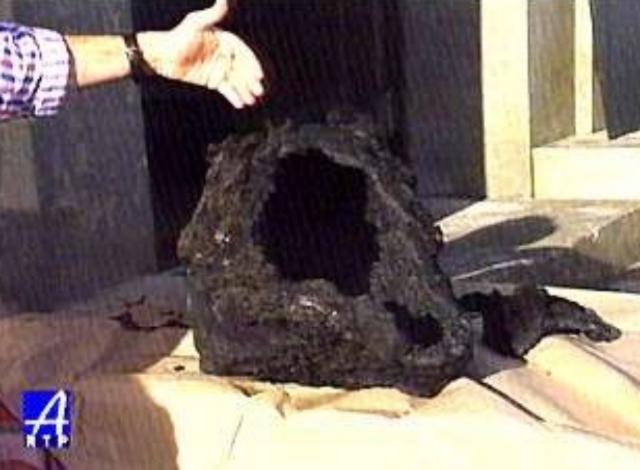Report on Terceira (Portugal) — March 1999
Bulletin of the Global Volcanism Network, vol. 24, no. 3 (March 1999)
Managing Editor: Richard Wunderman.
Terceira (Portugal) Migrating vents; floating blocks with large internal cavities ("lava balloons")
Please cite this report as:
Global Volcanism Program, 1999. Report on Terceira (Portugal) (Wunderman, R., ed.). Bulletin of the Global Volcanism Network, 24:3. Smithsonian Institution. https://doi.org/10.5479/si.GVP.BGVN199903-382050
Terceira
Portugal
38.73°N, 27.32°W; summit elev. 1023 m
All times are local (unless otherwise noted)
During February and March 1999 the submarine eruption that began late 1998 continued at the Serreta volcanic ridge, ~9-14 km W of Terceira island (BGVN 23:01; Luis and others, 1999). The activity decreased slightly until the end of February, but eruptive areas clearly defined two main volcanic trends in both NE-SW and NW-SE directions (figure 2). In March, activity became less vigorous and observers saw sea surface manifestations only during intermittent short periods.
The eruption of Serreta is interpreted as being a fissure-style vent that started along a NE-SW fracture system over 5 km long. During the eruption, the regional NW-SE fracture system also reactivated and eruptive vents developed on these two main trends. Plotting vent locations on published bathymetric maps made by the Instituto Hidrográfico puts them at depths of 300-800 m. However, bathymetric surveys carried out by the Portuguese Navy between January and March detected big anomalies in the area, perhaps due to gas bubbles, volcanic particles, and sharp thermal boundaries. Well-constrained depths for the active vents remain unknown and construction of a new bathymetric map of the area was planned for April.
This eruption involved basaltic, and probably very gas-rich, magma. Petrographic studies of the collected rock samples revealed olivine, pyroxene, and feldspars phenocrysts in a glassy groundmass with similar microlites that also include oxides. Chemical analysis made by colleagues from the Nordic Volcanological Institute showed that it is an alkaline magma with a composition along the magmatic trend defined by the Azores oceanic island basalts.
Floating blocks were seen on the surface (BGVN 23:01) and some were collected (figures 3 and 4). The scientific team attributed their seismic observations coupled with the floating blocks to the following mechanism. The magma, being low in viscosity, moves very easily through the already opened fractures and was thought to escape without producing high seismic signals. Floating lava blocks could result from the detachment of pillow-lava edges followed by the ascent of blocks with sufficient gas content. It is also possible that hot, gas-rich lava fragments result from small submarine lava lakes or fountains. A thin frozen skin of lava seals the gas cavity, and the block might then rise as a hot lava balloon. During ascent, the gas exsolves and nucleates inside the hot fragment while the blocks expand. Once at the surface the interaction between the hot blocks and the seawater produces white steam columns. At the same time, while cooling at the surface, the blocks crack slowly, lose their magmatic gas and sink. Sometimes when water enters inside the hot blocks, they blow up, violently throwing fragments several meters high.
 |
Figure 4. A sub-spherical floating block (a "lava balloon") from the Serreta eruption collected on an undisclosed day. Taken from Radiotelevisão Portuguesa (April 1999); URL: http://www.rtp.pt/. |
Since the beginning of this volcanic crisis the physical and chemical parameters of waters and fumarolic gases from the Terceira Island have been monitored and no changes have been detected. Azores Civil Protection (SRPCA) devised a series of emergency plans.
Another submarine eruption took place near the current one in mid-1867 (figure 1). Five months of strong seismicity around the time of the eruption destroyed about 200 houses on Terceira in the coastal settlement of Serreta. Websites associated with Azores civil defense and a local TV station have more photos of the eruption, including floating blocks.
References. Azores civil defense website, April 1999, Açores crise sismovulcania: URL:.
Luis, J.F., Lourenço, N., Miranda, J.M., Gaspar, J.L., and G. Queiroz, 1999, A submarine eruption W of Terceira Island (Azores Archipelao): InterRidge News, Initiative for international cooperation in ridge-crest studies, vol. 8, no. 1, Spring 1999, p. 13-14.
Machado, F., 1967, Active volcanoes of the Azores, in Neumann Van Padang, M., and others, 1967, Catalogue of the Active Volcanoes of the World: International Assoc. of Volcanology, Part XXI, p. 28-30.
Geological Summary. Terceira Island contains multiple stratovolcanoes constructed along a prominent ESE-WNW fissure zone that cuts across the island. Historically active Santa Barbara volcano at the western end of the island is truncated by two calderas, the youngest of which formed about 15,000 years ago. Comenditic lava domes fill and surround the caldera. Pico Alto lies north of the fissure zone in the north-central part of the island and contains a Pleistocene caldera largely filled by lava domes and lava flows. Guilherme Moniz caldera lies along the fissure zone immediately to the south, and 7-km-wide Cinquio Picos caldera is at the SE end of the island. Historical eruptions have occurred from Pico Alto, the fissure zone between Pico Alto and Santa Barbara, and from submarine vents west of Santa Barbara. Most Holocene eruptions have produced basaltic-to-rhyolitic lava flows from the fissure zone.
Information Contacts: J.L. Gaspar, T. Ferreira, G. Queiroz, R. Coutinho, M.H. Almeida, N. Wallenstein, and J.M. Pacheco, Centre of Volcanology of the Azores University (CVUA), Departamento de Geociencias, Rua da Mae de Deus, 9502 Ponta Delgada, Azores, Portugal (URL: http://www.uac.pt/).



